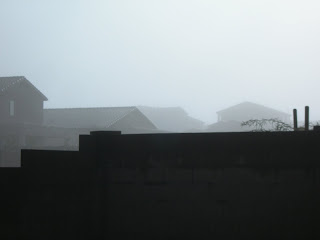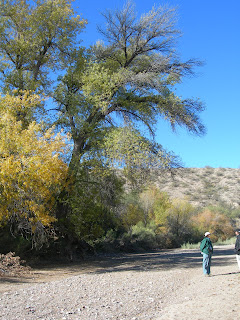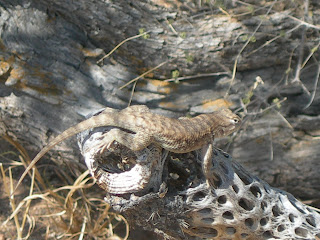Finally a team was assembled to begin an Important Bird Survey in Sabino Canyon. Emails had been exchanged for two weeks. It was decided that we would meet at 8 a.m. on November 14 at the Sabino Canyon Visitor Center. None of us had met each other, but we all agreed to identify each other by our hats and binoculars—standard fare for bird watchers. Our plan was to get to know each other and hike into the creek to walk the transect route for future surveys. Once again I got up early, fed cats, and dogs, ate breakfast and walked the dog.
My husband and I left at the planned time of 7 a.m., which I thought would get me to Sabino Canyon on the north side of Tucson in plenty of time. We stopped at the Roadrunner market in Corona De Tucson where Gus filled my gas tank as well as his. I had put all my birding gear in the car the night before in order to save time in the morning. The weather was suppose to be in the 80’s, so I had not brought a jacket with me. However, when I opened the window to talk to Gus at the gas station a chill breeze blew through. I suddenly remembered how cold it was birding in Green Valley the week before, so when the gas tank was full, I decided to head home for my jacket—just in case. Wrong move.
After retrieving my jacket, which took about 10 minutes, I headed north on Houghton Rd. The drive to Sabino Canyon took me much longer than anticipated. By the time I arrived it was twenty-five minutes after eight. Birders wait for no one, though I suspected they had waited a few minutes. Now what to do? I had never been here before and had no idea where the riparian area was. However, I really wanted to meet these women and see where we would be birding. Undaunted, I went into the visitor’s center and asked where the riparian area might be. I knew from the emails it was only a mile in and they were hiking there, so I knew I could do that also.
After obtaining instruction and a map from one of the volunteers I headed for the Sabino Dam Trail. In spite of my fears of being cold, it was quite warm and I didn’t take my jacket with me. Dressed in a T-shirt, light sweater and crop pants I was comfortable with my camel pack on my back and a granola bar in the pocket. The dirt trail was wide and golden in the morning sun. Long shadows lay across the trail. In the brush I spied a phainopepla, a silky flycatcher with black feathers and a crest. I walked on, unsure of myself, but determined.
Along the way I met other hikers already returning from their morning hikes. I asked one and then another if they had seen three women with hats and binoculars. No one had. Another women walked towards me with a floppy hat and a walking stick. Her hair was shoulder length platinum gray/ blond. A thin nose separated kind eyes. Older and shorter than I, she looked like a forest gnome. I asked her the same question. She had not seen the women either but offered to accompany me when she heard this was my first time in the canyon. I took her up on her offer and we introduced ourselves. Her name was Beth.
Beth and I headed farther up the trail, chatting as we went. She told me that mountain lions had been seen in this area and she didn’t want me to go alone. We talked about lions and birds and nature. Beth told me she lived nearby and often walked this trail. I looked about me at the high rock walls closing in around us. The creek bed was mostly dry, but during the Monsoon it had raged with water. Two people were swept away during a flash flood just this summer and drowned. Walking in the rocky and sandy creek bed now, it was hard to imagine.
We got out of the creek bed and back on the trail. Soon we came to the dam. Bamboo grew thickly along the creek edges, along with cottonwoods, sycamores and willows. "This is where the lion was spotted," Beth told me. We crossed the damp creek bottom to the other side, but then returned. I wanted to walk up the creek bed, but Beth suggested we stick to the trail. "I don’t think they will be in the creek," she said. I thought to myself, "that’s exactly where they will be," but I followed on.
The smooth beaten path wound through more bamboo and trees. We could not see very far ahead or even off to the sides. I was beginning to think we would never find the others when we came to a bend in the trail and there ahead of us were three women with binoculars, hats and a clipboard, walking up the creek. "Are you Jean, Pam, and Peggy," I called out. The three women turned to look at me, astonishment on their faces. We had found them! Beth graciously retreated, but not before I thanked her profusely. She was a guiding angel for me. A forest gnome with a walking stick.
I joined the others and introduced myself. I apologized for being so late. We continued our trek up the creek searching for the best path to take and deciding where we might stop for point count surveys come breeding season.
The creek snaked through the canyon past rocky cliffs. In places there was water lying in pools. The mud and sand adjacent to it held footprints of animals other than dogs or cats. They reminded me of raccoon footprints. Could they be coati’s? Beth had told me she has seen them here before. Farther up the creek two rock wrens bobbed and called from scattered stones. Then we saw a flash of chestnut as a canyon wren scurried in and out of the rocks looking for insects. In a thicket in the middle of the creek a tiny bird scolded and chattered at us. We never got a good look, but the others thought it might be a Bewick’s wren. On some stones in the middle of the creek someone spotted a tiny tree frog the gravelly color of stone. It blended right into the rock and was no bigger than a pebble. I was surprised anyone even noticed it, then concerned there may be more and I might step on them.
We finally climbed out of the creek at Tram Stop One. Sabino Canyon has a paved road it uses to transport people farther up the canyon. You pay $5 to ride the tram and can get on and off as many times as you want to. I haven’t ridden it yet but I was told it use to go all the way up 9 stops to the top. A huge flash flood a couple of years ago wiped out the road and now you can only ride to stop 4, but repairs are being done and the hope is you will be able to ride all the way to the top again.
Here in Sabino Canyon, which is a National Park, they actually have restrooms with flush toilets. We all took a restroom break before heading back down the canyon. As I sat on the seat I pulled the toilet paper down and was startled when something fell out of the roll! There on the floor was another tiny tree frog! This one was a bit larger, about the size of a dollar coin, with reddish toes like suction cups and a translucent tan body. I gently cupped the poor creature in my hands and escorted it outside the building. I dreaded the thought of some one stepping on it or, heaven forbid! —flushing it down the toilet! It stuck to the brick exterior on the side of the building with no trouble. It was the highlight of my day!
We hiked out of the canyon two by two. Jean and Pam chatted with each other up ahead while Peggy and I got to know one another. It had grown even warmer while we were hiking and I had removed the light sweater long ago. I never needed my jacket and if I hadn’t gone back for it I would have been on time, but I never would have met Beth or had such a fun adventure!




















































